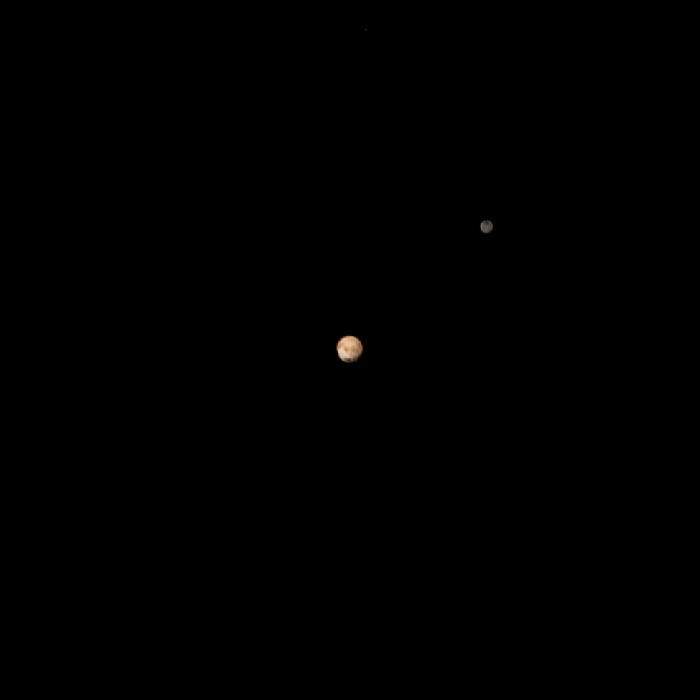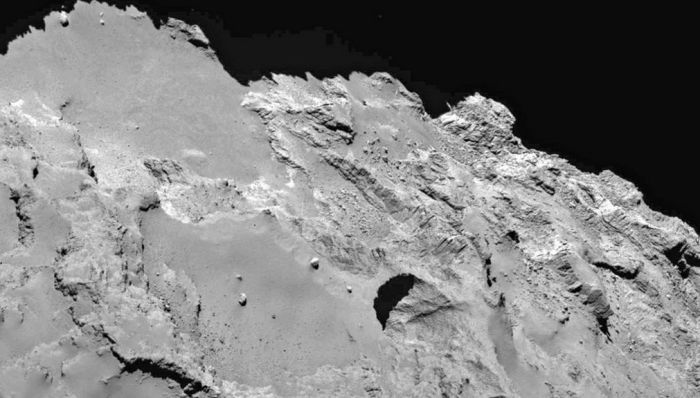 Operations on and around Mars are resuming following the June 2015 conjunction, which saw Mars and Earth on opposite sides of the Sun, a time which makes reliable two-way communications hard-to-impossible due to the Sun’s interference, so vehicles operating on and around the Red Planet are placed in autonomous modes of relatively safe operations.
Operations on and around Mars are resuming following the June 2015 conjunction, which saw Mars and Earth on opposite sides of the Sun, a time which makes reliable two-way communications hard-to-impossible due to the Sun’s interference, so vehicles operating on and around the Red Planet are placed in autonomous modes of relatively safe operations.
For the NASA rovers, Opportunity and Curiosity, this meant parking and waiting for reliable communications to be restored. However, now that Mars has once again emerged from “behind” the Sun, Curiosity is preparing to study the confluence of at least two different types of rock formation on the slopes of “Mount Sharp”.
As noted in my recent Curiosity updates, the Mars Science Laboratory (MSL) had been attempting to reach such a confluence, dubbed “Logan Pass”, but the terrain leading to that location proved more difficult from had been hoped. As a result, the rover was redirected towards another point leading up to higher elevations dubbed “Marias Pass”, and a small valley where the rock formations meet.

The two types of rock are a pale mudstone, similar in appearance to the bedrock studied at “Pahump Hills”; the other is a darker, finely bedded sandstone sitting above the Pahrump-like mudstone, which has been dubbed the “Stimson unit”. In addition, the valley also has a sandstone with grains of differing shapes and colour which the science team wish to examine in more detail as well, having already identified a potential target within it they’ve named “Big Arm”.
“On Mars as on Earth, each layer of a sedimentary rock tells a story about the environment in which it was formed and modified,” NASA spokesman Guy Webster said during a status update on the mission which explained the science team’s interest in the area. “Contacts between adjacent layers hold particular interest as sites where changes in environmental conditions may be studied. Some contacts show smooth transitions; others are abrupt.”
Curiosity is expected to spend the next few weeks examining the rock formations before resuming its trek up the side of “Mount Sharp”.
Dawn Over Ceres

On Monday, June 30th, The joint ESA / NASA Dawn deep space mission completed the second of its orbital mapping phases of Ceres, which it has been carrying out since May at a distance of some 4,400 kilometres (2,700 miles).
During July, the spacecraft will engage in a series of gentle manoeuvres that will allow it to reduce its orbit to 1,450 kilometres (900 miles), ready to start a further surface mapping and investigation mission in early August.
Ceres has revealed it has a much more varied landscape that Vesta, its slightly smaller “sister” protoplanet, which the Dawn spacecraft studied over a prior if 14 months in 2011/12, prior to reaching Ceres in March 2015. One particular point of interest on the latter is a grouping of bright surface features located within a crater some 90 kilometres (55 miles) across.
The most recent images returned be Dawn of these spots reveals they are more numerous than had first been thought, with the largest approximately 9 km (6 miles) across. It is believed these bright spots are the result of ice or salt, although other causes may be possible; spectra of the region should reveal far more as the spacecraft reduces its orbit.

In addition to the bright spots, the latest images also show a pyramid-like mountain with steep slopes rising to a height of about 5 km (3 miles) from a relatively flat area on Ceres, which has also provoked scientific interest. Ceres is also richly cratered, like Vesta; however, unlike Vesta, many more of the craters on Ceres have central peaks associated with them, evidence of their formation being the result of surface impacts. Images have also revealed evidence of other activities on the rocky, barren surface: slumps, landslides and lava-like flows, all indicative of Ceres perhaps having been somewhat more active in its formative years than Vesta.
Pluto: The Final Countdown

On July 14th, travelling at some 13.78 km/s (30,000 mph), the New Horizons space probe will sweep past Pluto, the first man-made craft to do so. Latest estimates show that New Horizons should pass the dwarf planet at a distance of around 12,500 kilometres (7,800 miles), although this distance is subject to final revision around 3 days before the period of closest approach, when the vehicle will make a final adjustment to it trajectory.
During closest approach, New Horizon’s battery of science instruments, including LORRI (the Long Range Reconnaissance Imager) and Ralph, the telescope system, will be closely focused on that distant, tiny world, gathering as much information as possible prior to returning it to Earth. Initial confirmation of the flyby will take some 4.5 hours to reach Earth, although imaging and other data obtained by the vehicle will take longer to be returned,
On July 3rd, NASA released an animated GIF which provides a tantalising glimpse of New Horizon’s headlong rush into the Pluto / Charon system. Compiled using multiple images captured at the end of June, the GIF shows Pluto slowly getting larger as the spacecraft approaches, with surface details slowly starting to reveal themselves as little Charon whirls around its partner seemingly at breakneck pace.

One thing New Horizons will be looking for with care during its flyby of Pluto, is the presence of clouds in the tiny world’s tenuous atmosphere. The discovery of any clouds, together with tracking their movement, will help provide further information on Pluto’s atmosphere, its composition and any possible atmospheric movements / weather patterns that are occurring.
Philae Problems
the European Space Agency is having a few frustrations where the Rosetta mission to comet 67P/C-G is concerned.
As reported in my recent Space Sunday updates, Philae, the lander element of the mission, recently woke up from a self-imposed 7-month hibernation on the surface of the comet. During a series of communications over the last few weeks, the lander has confirmed it is in good health – good enough to resume science activities as the comet continues on is path towards and around the Sun.
All this is positive news; however, the frustration is born of the fact that since initially confirming its status, Philae has been unable to remain in stable communications with its parent vehicle, Rosetta, as it orbits the comet. In mid-June, the orbiting vehicle was order to adjust its orbit in the hope of stabilising communications – which are problematic as the exact location of the lander still hasn’t been verified following it’s hour-long “bounce” over the comet’s surface when it failed to anchor itself on initial touchdown in November 2014.
However, it might also be indicative of a communications issue as well; there’s currently no way of knowing. It had been hoped that by manoeuvring Rosetta into a new orbit around the comet in mid-June would naturally improve line-of-sight communications, but this didn’t happen, and the science team have been unable to establish a link with the Lander since June 24th, 2015.
In an attempt to discover what might actually be the case, the Rosetta Team plan to use a science experiment split between the orbiter and lander in an attempt to test communications between the two.
CONSERT (COmet Nucleus Sounding Experiment by Radiowave Transmission) uses an additional antenna system for data exchanges between the orbiter and the lander. So the idea is to have the orbiter send a series of requests for the lander to turn on its end of the CONSERT experiment. Should Philae send data back over the CONSERT uplink, it will be indicative that there is a primary communications issue between the orbiter and Philae, and engineers can start attempting to track down potential issues.

Meanwhile, Rosetta has imaged a number of deep and circular pits on the comet’s surface which all appear to be relatively new. It is thought these pits, which range in diameter from around 10 metres to several hundred kilometres, are the result of caverns being formed as subsurface ice is melted and outgassed water vapour as the comet’s interior continues to be heated, and the rock above the caverns collapsing under its own weight, leasing s sinkhole.
All images courtesy of NASA / JPL unless otherwise stated.
I read the news: New Horizon signal is lost.
Horrified faces.
Then communication has been reestablished, but the probe was in safe mode. It looks like it was a timing flaw in the spacecraft command sequence. They aren’t going to do it again. Plans are to return to normal operation on July 7 – with a 8.8 hour round trip communication delay, it takes a while.
/me takes a sigh of relief
Good that it happened now and not during the fly-by.
I like your space posts, lots of amazing things this year 🙂
LikeLike
Yup. I was away for a good portion of the weekend (and have only just got home), so the last few posts, including Space Sunday, were written in advance and then published using WordPress’s scheduled publishing option – so I as unable to update with news on the fault.
As it is, the switch to the safe mode appears to have been caused by the vehicle’s main computer trying to write the new information to its flash memory while at the same time attempting to compress a rich set of existing data for transmission to Earth – something the system isn’t designed to do. Communications have now been restored, and it is estimated that around 6% of the data gathered between the 4th and 6th July has been lost, which represents less than 1% of the overall science data returned as New Horizons approaches Pluto / Charon.
LikeLike